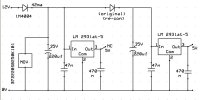Am I missing something here or is there something wrong with this circuit design?
The first regulator having no output connection may as well not be there, the capacitor on the output should be a minimum of 100uf to maintain stability. The regulator being an AT series will shutdown at pretty much anything >40v shortly after negating its' 60v load dumping feature thus protecting itself and its' load.
The MOV has a clamping voltage of 77v, the original kicked in and dropped to 7 ohms which gives a minimum of 11A current flowing through a 1A rated diode. We only know the clamping voltage but the actual input voltage may have been much higher.The heating time of the diode would be extremely short and obviously track damage would occur.
Spectre posted that his mate said load dumping can cause voltages in the 20V region, I have read that they can be in the region of 120v. Don't know about this though, automotive electronics wasn't my thing.
In Danforths' nicely reverse engineered circuit it shows 2 forward biased diodes in series, why bother? The input diode dies shortly after the MOV kicks in if overvoltage is sustained and current would no longer flow through the second diode as soon as the MOV kicked in anyway.
The MOV has a fast reaction time of around 4ns and will quickly react to shunt excess to ground. A fuse is slower and especially in this case you would opt for an anti-surge which should remain intact after the MOV had shunted transients/spikes and returned to its' normal operating voltage and open resistance status. If on the other hand the excess voltage wasn't due to transients/spikes and continued the fuse wire will melt and possibly shatter the glass but save the board and tracks. The diode if used instead, slower and obviously having heated externally with everything it is in contact with suffering damage.
The regulator outputs around 100ma so I would have been tempted to insert a fuse rated at 125ma anti-surge and as Spectre posted solder another MOV in parallel with the other.
I was only a repair engineer not design so clearly there is something I am missing here.
Don't think you're missing anything, didn't make much sense to me either, but we don't know what's plugged in externally.
I double checked the track layout before posting, so it's the only thing I'm certain about. The remains of the "frazzler" does have a band on it, and a diode is the only
polarized 2 pin, (series) component that I could think of. As you say, a fuse wouldn't have done the damage, but the original component had worked for around 15 years.
Without knowledge of the external circuitry, replacing like with "best guess" seemed the safest course (at least till we know whether the tractor works or not).
I can only assume the redundant reg is fitted to standardize pcb's across different models, link connected if needed, not used on this.
The caps across the reg o/p's are smd marked 47-10 K1, with 2 (inside a circle). They are polarized, now I've had another look, didn't seem important just for schematic,
so probably higher values.
As for MOV's, I've only ever changed them for original, or known equivalents, before now. I know the caps across the 12v supply from the "frazzler" are 35v max.
I'm assuming transients over 35v will damage them, so chose highest voltage MOV which should shunt under 35v ( 25vac, 31vdc, according to spec).
If you think a higher voltage MOV won't damage the caps, I'm open to suggestions.

